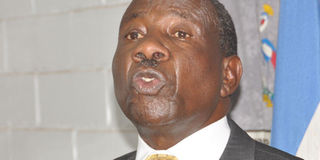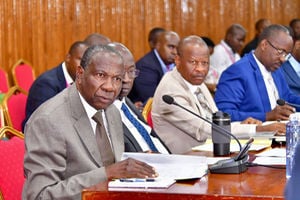Shs41 trillion national debt is sustainable, says government

The Minister of Finance, Mr Matia Kasaija
Kampala- Government yesterday assured Ugandans that the Shs41.3 trillion debt is sustainable because the money being borrowed is invested in projects that will help expand the size of the economy.
The Minister of Finance, Mr Matia Kasaija, told journalists yesterday at the Uganda Media Centre in Kampala while responding to a public outcry on the increasing debt burden.
This follows the Auditor General, Mr John Muwanga’s, report to Parliament last week which indicated that the public debt had increased by 22 per cent from Shs33.99 trillion as of June 30, 2017 to Shs41.51 trillion as of June 30, 2018.
Although Mr Muwanga stated that Uganda’s current debt Gross Domestic Product (GDP) ratio stands at 41 per cent, which is still below the “IMF risky threshold of 50 per cent,” and compares well with other East African countries, he warned that the figure is unfavourable when debt payment is compared to the country’s revenue collection.
Mr Kasaija said there was no reason to “worry” because the government through different strategies has improved the loan absorption rate from 40 per cent in FY 2014/15 to 76 per cent in FY 2017/18, respectively.
“I would like to assure the country that our debt is sustainable, and is projected to remain sustainable in the medium to long term. The debt levels are comfortably below the international sustainability thresholds (below 50 per cent debt to GDP ratio) beyond which debt starts getting unsustainable, and are significantly below the sub-Saharan average (45.4 per cent debt to GDP),” Mr Kasaija said.
He broke down the current debts as Shs27.9 trillion ($7.2b) as external debt which is borrowed majorly from China, Japan and the World Bank among other sources, and Shs13.3 trillion ($3.5b) worth of domestic debt.
Mr Kasaija said government was borrowing more from abroad than domestically because the external debts have a lower and favourable interest rate compared to the ever increasing interest rates on domestic borrowing.
The minister listed the measures by government to address absorption challenges such as ensuring strict adherence to the project investment management system (PIMS) process by financing projects that have fulfilled the PIMS requirements, ensuring adequate provision of counterpart funding for respective votes specifically to address compensation requirements and Project Affected Persons (PAPs) to acquire the right of way.
Interventions
Others are providing capacity development for ministries, departments and government agencies in project development and contract management which is ongoing, regular review of the public investment plans to identify projects that have ended and create fiscal space from within the budget for financing new projects.
Mr Kasaija said government has provided money for the repayment of debts in the FY 2018/19 and more has been catered for in the current budget cycle for the FY 2019/20.
Tasked to explain how government is prepared not to lose assets to foreign creditors such as the Chinese as reported in other African countries, Mr Kasaija said Uganda owes Shs1.58 trillion to China because the revenue base is expanding.
“I have heard about China taking over assets elsewhere but as long as some of us are still here, no way. They can do it anywhere but here, I don’t think they will come because we are not going to lead your country into debt stress,” the minister said.
Government allocated Shs10 trillion out of the Shs32.7 trillion budget for the FY 2018/19 to repay public debt. This is against the Shs16.3 trillion revenue projection in the same financial year.
Already, the Civil Society Budget Advocacy Group (CSBAG) has raised a red flag over the Budget Framework paper for the FY2019/20, saying almost the Shs34 trillion proposed budget is being allocated to debt repayment leaving service delivery underperforming.
The CSBAG executive director, Mr Julius Mukunda, last week said there are threats that the debt to GDP threshold may exceed the limit of the 50 per cent of the regional threshold if government implements other debt financing heavy projects such as the standard gauge railway.
However, Mr Kasaija said when government finishes working on major infrastructure projects, the cost of production and transport of goods and services will be low whereas the levels of income will increase hence a stable tax base to clear the debts.
The minister added that government has been making mistakes in resorting to loans before settling compensation with PAPs which makes it difficult to start on the projects because of variations in property valuation.
Obstacle to repayment
Mr Kasaija said the only challenge to the loan-funded projects is the issue of compensation over land where government infrastructural projects are planned to be undertaken.
These he blamed on the rigidity of Ugandans for not allowing the amendment of Article 26 of the Constitution so that private land is taken over pending negotiations. Most of such loans require co-funding by government which money is supposed to cater for issues of compensation, among others.
Most of the top infrastructural projects being undertaken include roads and power dams.



